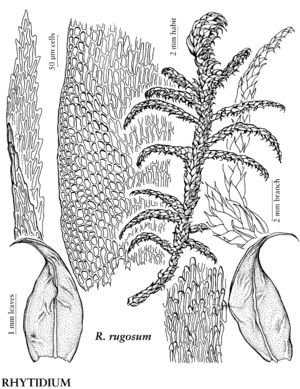familyRhytidiaceae
genusRhytidium
Show Lower Taxa
Difference between revisions of "Rhytidium"
Bih. Kongl. Svenska Vetensk.-Akad. Handl. 6(19): 8. 1882.
Etymology: Greek rhytis, wrinkle, alluding to strongly rugose leaves
Basionym: Hypnum sect. Rhytidium Sullivant in A. Gray, Manual ed. 2, 675. 1856
imported>Volume Importer |
(No difference)
|
Latest revision as of 07:45, 30 July 2020
| Taxon | Illustrator ⠉ | |
|---|---|---|
 | Rhytidium rugosum | Patricia M. Eckel |
Stem-leaves erect, crowded, imbricate, falcate-secund, obscurely plicate, strongly rugose; base not or short-decurrent; laminal cells coarsely prorate at distal ends. Branch leaves similar, less falcate-secund, smaller. Capsule oblong-ellipsoid to cylindric, arcuate, not plicate, constricted below mouth when dry; operculum high-conic to short-rostrate. Spores 10–17 µm.
Distribution
North America, Mexico, Central America (Guatemala), South America (Bolivia), Eurasia, Africa
Discussion
Species 1.
Selected References
None.
Lower Taxa
"broad" is not a number.
... more about "Rhytidium"
acuminate +
short-decurrent +
falcate-secund +
smaller +
naked +
cucullate +
arcuate +
suberect;horizontal +
oblong-ellipsoid;cylindric +
constricted +
quadrate;short-rectangular +
connate +
2-fid +
cross-striolate +
papillose +
revolute +
linear-flexuose +
high-conic;short-rostrate +
absent +
lanceolate;narrowly lanceolate +
Bih. Kongl. Svenska Vetensk.-Akad. Handl. +
1882 +
perforated +
elongate +
narrow +
erect +
rugose +
procumbent +
erect-ascending +
Rhytidium +
Rhytidiaceae +
genus +
present +